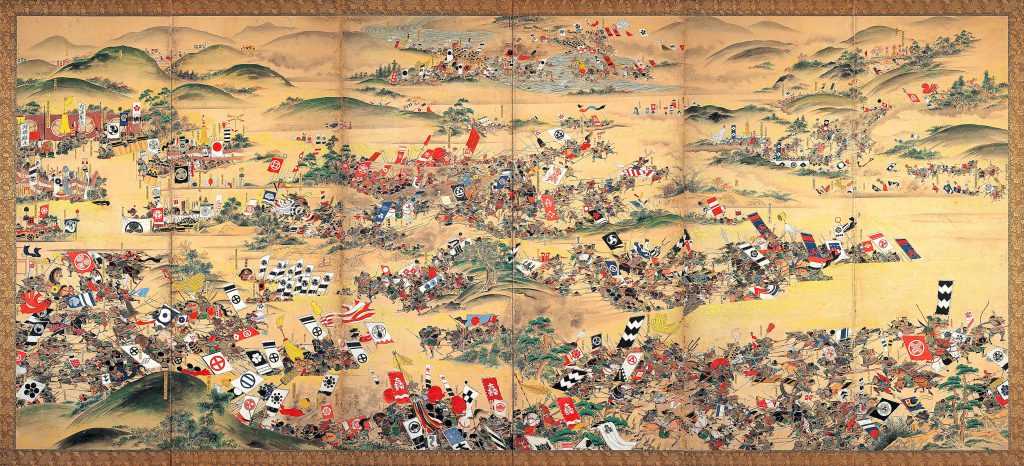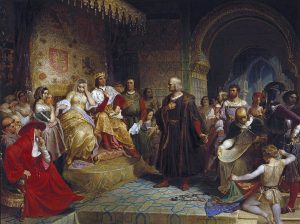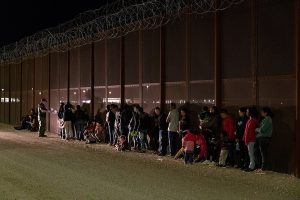The Battle of Sekigahara took place in Japan near the end of the Sengoku Jidai or The Warring States Period (1467-1615). These nearly 150 years were the most violent times in Japanese history, where warlords battled each other for land and power. Since this period lasted for so long, the way battles were fought had changed. The first battle of the Sengoku Jidai that happened in 1467, called the Onin War, was fought with bows and swords, but by the end of the era, battles were influenced by the introduction of European cannons and guns. The Onin War, which started it all, had lasted for ten years and was instigated by the Hosokawa and Yamana clans. At that time, the capital of Japan was Kyoto, which housed the Ashikaga Shogunate, and it was the Ashikaga that held authority over the country. In the city, both clans owned mansions and their rivalry took a turn for the worse. The two clans fought in the city, and others who were caught in the crossfire had to choose to side with one or the other to protect themselves. Soon the situation spiraled out of control and the shogunate was not able to quell the fighting. The Onin War caused a domino effect that started with the Hosokawa and Yamana clans, and year by year the whole country was at war.1
During the Sengoku Jidai, there were three great unifiers, the first being Oda Nobunaga, who conquered central Japan. He started making waves in 1560, when a powerful warlord attempted to take over Nobunaga’s territory. Severely outnumbered by the invading Imagawa clan, Nobunaga managed to take Imagawa Yoshimoto by surprise under the cover of a thunderstorm and killed him. This victory marked the beginning of Nobunaga’s conquest of central Japan and was now aided by fair weather clans who had supported Imagawa. Eight years later, in 1568, with the help of his ally Tokugawa Ieyasu, who was watching his back, Nobunaga started his march towards Kyoto to remove the shogun and put himself in power. Needless to say, this aggressive move was not well received by the other warlords, who felt threatened by Nobunaga taking control of Kyoto. Doubly so by Ieyasu moving from his castle in Okazaki to another more advantageously positioned Hamamatsu castle in 1570. The location of Hamamatsu castle was at the mouth of the Tenryugawa river, which starts in the territory owned by Nobunaga’s rival Takeda Shingen. The Takeda clan was another prominent force that should not be taken lightly. Takeda Shingen marched in the snow towards Hamamatsu castle and had forced Ieyasu’s forces back behind the walls. After the defeat, Ieyasu’s general Torii Mototada had ordered the gates to be closed. Ieyasu knew that that was what Shingen wanted, so he told Mototada to leave them open and light fires to guide the retreating troops back. Surprised by this, Shingen thought that the gates being left open was a trap, so he decided not to storm the castle and had his troops camp out in the cold. Making use of the terrain, Ieyasu had sent out 16 riflemen and 100 other foot soldiers at night to attack their camp. The Takeda were known for their horsemen, but in this case it was their downfall when the Tokugawa troops led the horsemen down to a ravine. Under the cover of darkness coupled with the snow, many of the horsemen could not stop in time and fell in, while the Tokugawa soldiers finished them off.2

Since Nobunaga’s conquest of Kyoto, things had been going well and he had become the most powerful man in Japan. In the summer of 1582, Nobunaga’s general Toyotomi Hideyoshi fought against the Mori clan on the west side of the country, while Tokugawa Ieyasu was fighting on the east side. Hideyoshi’s battle at Mori’s Takamatsu castle stagnated, and he was unable to break through the Mori defenses. In order to win, he decided to request reinforcements from Nobunaga. What Hideyoshi didn’t know was that his request came with a major consequence. Nobunaga had sent out his troops in advance under the command of another general by the name of Akechi Mitsuhide and he would catch up to them at Takamatsu castle. This had left Nobunaga unguarded, and at night Mitsuhide turned the army around with the intention of betraying Nobunaga. During the attack, Nobunaga was staying at Honnoji temple in Kyoto when Mitsuhide’s troops arrived and set the temple ablaze, knowing that he could not escape, Nobunaga took his own life and died in the fire.3
After the event, Mitsuhide declared himself the Shogun, and after hearing the news, Hideyoshi surrendered his assault and took his troops back to Kyoto. Surprised that Hideyoshi returned so quickly, Mitsuhide was caught off guard and had his troops position themselves on a hill by the Yodo river; but it was for naught. Hideyoshi had routed the enemy who had dispersed in all directions, and Mitsuhide died at the hands of a peasant gang.4 But Hideyoshi’s work was far from over; he could not be the shogun because he was not from a notable family; so he became the civil prime minister. Hideyoshi picked up where Nobunaga left off and became the second great unifier. And by 1591, he had control of the entire country. Seven years later, in 1598, Hideyoshi became ill and his heir was only five years old. Before he died, Hideyoshi held a meeting with five of the strongest warlords and made them swear to rule together along with five commissioners until his son was of age to take his father’s spot. The five warlords were Tokugawa Ieyasu, Maeda Toshiie, Uesugi Kagekatsu, Mori Terumoto, and Ukita Hideie. Hideyoshi had made Toshiie the guardian of his son along with Tokugawa Ieyasu. Then on September 15, 1598, Hideyoshi had succumbed to his illness.5
This was where the scheming and working in the shadows took place, because everyone knew that the country was not going to remain peaceful, now that Hideyoshi was dead. The first to start the scheming was Ishida Mitsunari, who was trying to decrease Tokugawa Ieyasu’s influence. After Ieyasu moved into the late Hideyoshi’s castle, Mitsunari went to Toshiie, who was the guardian of Hideyoshi’s son, to try and turn him against Ieyasu. Luckily for Ieyasu, Hosokawa Tadaoki was there to counteract Mitsunari’s scheming and convinced Toshiie and his son that it would be in his best interest to not mess with Ieyasu. Having his plan backfire, Mitsunari then chose to stage an assassination of Ieyasu, but that too failed when Ieyasu’s generals found out about it. They had decided to kill Mitsunari, and in a surprising turn of events, Mitsunari fled for his life and sought protection from Ieyasu. No one knows why Ieyasu granted Mitsunari protection, but his choice made the future tougher for himself.6

So, who was this Tokugawa Ieyasu? He held territory in the “breadbasket” of Japan, which made him a very wealthy and powerful man. Power was determined by how much food-bearing land someone controlled, and Ieyasu’s territory in the Kanto region provided him with 2.5 million koku. One koku is 180 liters of rice, which is enough to feed a man for one year. Coupled with being rich, Ieyasu had chosen strong allies; he was on Nobunaga’s side, while other clans perished while trying to oppose him; and he was smart enough to back Hideyoshi’s rule. After Maeda Toshiie died, Ieyasu became the guardian of Hideyoshi’s son Hideyori, and he moved into the Osaka castle where Hideyoshi was staying. This angered the commissioners and warlords, including Mitsunari. But during that time Ieyasu also dealt with the troublesome Uesugi clan that was to the east of Japan. Mitsunari saw this opportunity, and himself and a group of others issued a complaint that Ieyasu believed was a declaration of war.7
Since the time of Hideyoshi’s death, everyone was forming alliances, and Ieyasu was no different. A rule that he broke being one of the rulers was that he could not marry off children for diplomatic reasons. But that was one of the ways he had formed alliances that allowed him to form the Eastern Army. The Eastern Army, led by Tokugawa Ieyasu, were the separatists who did not want to wait for Hideyori’s son to rule. When the Eastern Army formed, Mitsunari then formed the Western Army, who were the loyalists. The whole country was now divided by whom they supported. Ieyasu had started the campaign in the east and split his army; he sent his son to attack the Sanda clan, while he led 30,000 men towards the west where Mitsunari was. Getting closer, Ieyasu ordered his subordinates to take Gifu and Kiyosu castles, which were on two important roads, while Mitsunari was taking Fushimi castle, whose defenses were strong and held up his army. After taking Fushimi castle, he moved on to Ogaki castle, where he met with the Eastern Army and had a skirmish in Akasaka. Nothing came out of it, but at night a couple of Mitsunari’s generals had posed a night battle and believed they had the upper hand. Mitsunari’s strategist scoffed at the idea, calling it weak, and Mitsunari called for a retreat to a more strategic location at a village in a valley called Sekigahara.8
The year was 1600, and both armies had arrived at around 1:00 am, but a torrential rain was coming down and by the time both had set up their positions, it was 4:30 am. Mitsunari’s plan was to draw the Eastern forces into the valley and surround them; two sides of the valley were blocked my mountains, which made running away difficult. The rain had let up and had turned into a dense fog. By 8:00 am, the fog had lifted and both armies were surprised by how close they were to one another. Both armies had around 80,000 troops, and the Eastern Army kicked off the battle with mounted cavalry led by Ii Naomasa and Fukushima Masanori straight to Ukita Hideie’s positon. The push had shocked the Western Army, and 20,000 more Eastern forces charged towards Mitsunari’s encampment. Mitsunari then had cannons fire upon the west to be used as a fear tactic, which succeeded, and forced his enemies back. Two hours had passed and only 35,000 of Mitsunari’s alliance had joined the battle. The Shimazu clan, 3000 in total, had not moved from their position. Angered by this, Mitsunari personally went to their camp and asked them to join the battle. Shimazu did not respond positively, which may have been because his advice about the night attack prior to the battle had been scoffed at.9

Another hour passed and the battle went back and forth with no clear winning side. Mitsunari, looking from a vantage point at Mount Sasao, had called for all of his forces to make a final push. Mitsunari had an ace up his sleeve; 15,000 men led by Kobayakawa Hideaki had been waiting on Mount Matsuo for Mitsunari’s call to charge at the Eastern Army. But before the battle, Hideaki had sent a letter to Ieyasu that told him that he would switch sides to the east. When Mitsunari signaled for Hideaki, he did not respond. At the same time, four other divisions and Kikawa Hiorie were ordered to attack, but they too defied Mitsunari’s orders. Hideaki having been given a push by Ieyasu and charged towards Mitsunari’s forces, and the Shimazu clan then fled from the fight. Overwhelmed, the remaining Western Army had lost and Mitsunari was captured and executed in Kyoto.10 Tokugawa Ieyasu was now the third great unifier, which led the country to 200 years of peace. His descendants had feared that foreign influence would thrust the country back into another age of war, so they turned away all foreigners, with only a few exceptions for trade.11
- Stephen R. Turnbull, War in Japan 1467-1615, Essential Histories 46 (Oxford: Osprey Publishing, 2002), 8-14. ↵
- Stephen R. Turnbull, War in Japan 1467-1615 Essential Histories 46 (Oxford: Osprey Publishing, 2002), 42-49. ↵
- Stephen R. Turnbull, War in Japan 1467-1615 Essential Histories 46 (Oxford: Osprey Publishing, 2002), 52-53. ↵
- Stephen R. Turnbull, War in Japan 1467-1615 Essential Histories 46 (Oxford: Osprey Publishing, 2002), 54. ↵
- Anthony J. Bryant, Sekigahara 1600: The Final Struggle for Power, Osprey Military Campaign Series 40 (London: Osprey, 1995), 7-8. ↵
- Anthony J. Bryant, Sekigahara 1600: The Final Struggle for Power Osprey Military Campaign Series 40 (London: Osprey, 1995), 9, 10, 12. ↵
- Anthony J. Bryant, Sekigahara 1600: The Final Struggle for Power Osprey Military Campaign Series 40 (London: Osprey, 1995), 8,12,13,14. ↵
- Anthony J. Bryant, Sekigahara 1600: The Final Struggle for Power Osprey Military Campaign Series 40 (London: Osprey, 1995), 12,13,38,39,41,49. ↵
- Anthony J. Bryant, Sekigahara 1600: The Final Struggle for Power. Osprey Military Campaign Series 40 (London: Osprey, 1995), 25,51-65. ↵
- Anthony J. Bryant, Sekigahara 1600: The Final Struggle for Power Osprey Military Campaign Series 40 (London: Osprey, 1995), 47,66-80. ↵
- Stephen R. Turnbull, War in Japan 1467-1615 Essential Histories 46 (Oxford: Osprey Publishing, 2002.), 87. ↵



85 comments
Amanda Gutierrez
Very informative article! Japanese history is something I really want be more informed about, and this article really taught me about Japanese politics. Leyasu was the most interesting person to read about while reading the article; he was illustrated as very cunning which made the article intriguing. Overall, this was well-written and very interesting article to read! Nice job!
Madeline Chandler
Such an informative and interesting article! Very captivating. Honestly I am unfamiliar with Japanese history and wish I knew more. This article gave such great information on military strategies, politics, and such a different side of history. Mitsunari, probably was the most intriguing to me. Because he had a plan at the end of the battle to win yet circumstances changed the entire projection of the battle and his life. I loved reading your article. Great job!
Lorena Lujan
I always like to read about history I’m unfamiliar with and this was a great telling of the conflicts that happened in Japan. How centuries of battles came from a squabble between two families and grew into conquests for the power and wealth. Tokugawa Ieyasu was the most interesting to me as he seemed to be the most cunning and resourceful.
Brandon Torres
I loved that the author went so in-depth regarding this article and especially, the battle of Sekigahara. This article’s descriptive nature regarding this war history is truly a grand read as it not exposes the battles and strategies, but also showcases the individuals who were at the forefront of these battles and skirmishes!
Davis Nickle
I never realized how uniformed I was about Japanese history, but this article really helped alleviate some of that ignorance. I was also pleased to learn how interesting the politics of the Japanese Shogunate, people like Hideyoshi, Ieyasu, and Mitsunari really interested me because of their influence and interaction with the history of Japan. I was also really impressed by the ingenuity of Ieyasu. This article really made for an interesting read.
Yazmin Garcia
It is amazing how Tokugawa Ieyasu was able to unify and maintain the nation for 200 years. It almost makes one wonder if that is why during the times of exploration they did very minimal to none of it themselves. Japanese history does not have enough exposure in world history courses. Or at least it did not for me when I was in high school or the one I took here while in University. So this article was definitely something new as a history lover.
Thiffany Yeupell
The amount of turmoil Japan went through to reach some semblance of peace for a time period is multitudes. With all the planning and scheming in the background, I’m surprised that the peace was able to last as long as it did, but it was probably due to the calculated leadership of the three great unifiers and their strategies of keeping warring parties from escalating their feuds. But even then, the human desire for power proves to be a contributing factor in Japanese history and its changes in rulers.
Alondra Lozano
This article was interesting. I did not know much about the history of Japan and their wars and this made me more knowledgeable. It involved a lot of warlords who overthrew dynasty’s and new rules that rose to power. That age of war in Japan brought a lot of change and it is crazy on how plans never go as planned.
Kendall Guajardo
This was a really interesting article! The fact that there were many clans who dominated different parts of the country at different times is pretty crazy. All in all a lot of the rulers and subordinates were power hungry and turned on each other any chance they could. I thought it was really interesting how there were separatists and loyalists to decide who was for and against the reign of his son. Even if the battle was in Ieyasu’s favor at least peace was restored for over two centuries. This seemed like a very chaotic way to run a country but no doubt very intriguing to read. Awesome article!
Andrea Degollado
I think this article was very interesting to read especially because many of us aren’t familiar with Japanese history, especially war history. I think its very interesting how Japan had initially started as an empire and is now a military force. Its crazy to read how many people assassinated one another to gain power. This was a very informative article and very well developed. Great job.